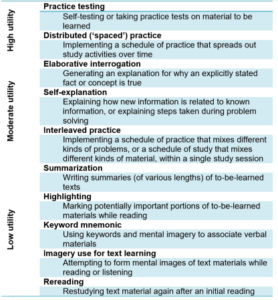It’s strange, throughout my teacher training and career, nobody has EVER run any professional development workshops on what makes for effective revision. No research has ever been discussed about what works or what doesn’t, certainly not with me. It is assumed we and the students know what effective revision is and how we do it. Are we too caught up in the relief (and/or tiredness) of covering the content, that revision becomes an afterthought?
My own revision practices were based upon practice questions (some timed) and a Nandos revision menu I ‘stole’ from social media. On reflection however, I was asking them to simply re-write their notes in a variety of forms – flash cards to mind-maps, wiki pages to posters – it was basically the same. These are the revision forms that the students are most comfortable with too – it is their comfort blanket in fact. They show them off, proud of their notes and how they have utilised their new coloured pens and highlighters. I am just relieved that they are revising, but without giving a thought as to whether what they are doing is effective.
However, according to a number of researchers – this type of revision is really ineffective. In fact, most of the techniques I was telling my students to do, or praising them for doing, fall under the heading of ‘low utility’ (see table) according to Dunlosky et al (2013). This study suggests that the more effective practices involved frequent testing with periods in between to allow the students to forget.

The findings of Dunlosky have been corroborated by others, including Bjork and Bjork (2011) who concluded that having to generate an answer or procedure, or having to retrieve information – even if no feedback is given – leads to better long-term recall than simply studying. P.K. Agarwal et al (2014) even added that students who used the testing method felt less stressed ahead of a test or exam.
The question is, what new and interesting ideas can we use as History teachers to test students in an effective but engaging way?
I have started using Kahoot, which is a great online quiz which the students can use their smartphones to answer (Wi-Fi permitting). I have a number of paper-based quizzes wherein I repeat some of the previous questions among new ones. However, It all feels a little repetitive. I want some new ideas for distributed testing. I want a toolbox of strategies that are fun but really help the students’ lockdown facts into their long-term memory – perhaps you can help?


